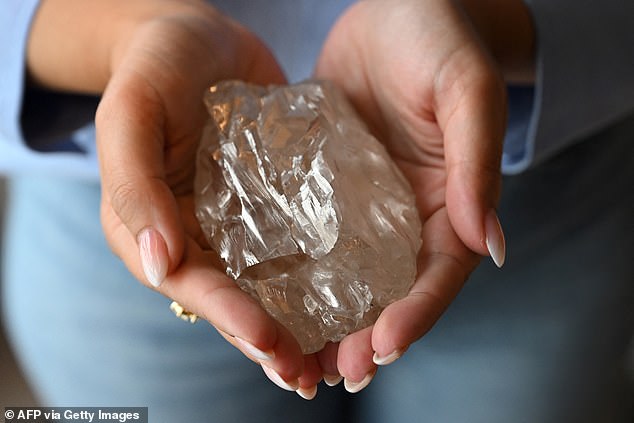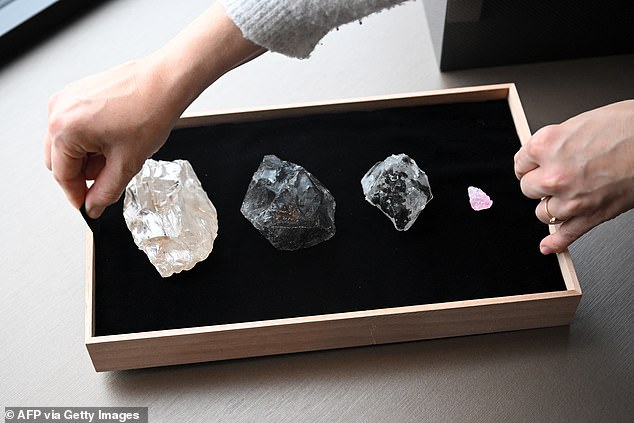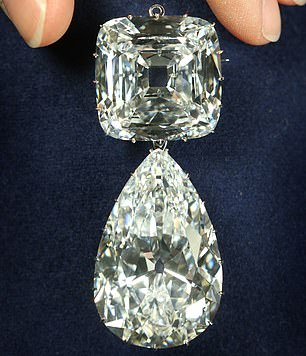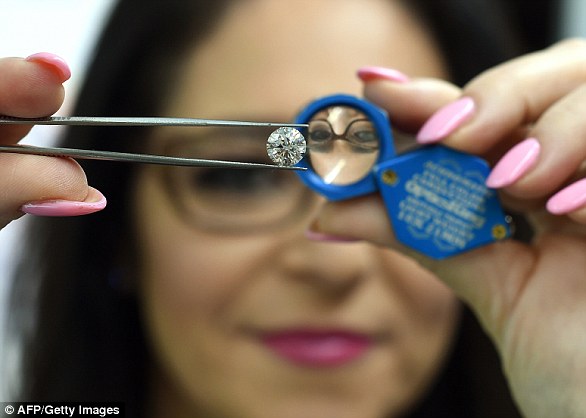The world’s second biggest diamond could soon find a new home in a museum of a sheikh’s collection – but only once it has been properly evaluated.
Unearthed in Botswana last year, the 2,492–carat stone is known as Motswedi.
Before it finds its home, gem dealer HB Antwerp needs to price it – something that is proving tricky.
‘At the moment it’s very hard to put a price on it,’ Margaux Donckier, HB Antwerp’s public affairs director told AFP.
‘We first have to inspect the stone and see what we can yield from it in polished form.’
The gem, uncovered by Canadian mining firm Lucara, is the largest diamond seen in the last 120 years since the discovery of the world–famous Cullinan Diamond.
The 3,106–carat stone was found in neighbouring South Africa in 1905 and was cut into nine separate stones, many of which now form part of the British crown jewels.
While the Motswedi hasn’t got a proper price tag yet, it has already received ‘plenty of interest from all over the world,’ Ms Donckier said.
The world’s second biggest diamond could soon find a new home in a museum of a sheikh’s collection – but only once it has been properly evaluated

HB Antwerp is showcasing the Motswedi alongside three other gems – including the world’s third largest diamond, which was recently found in the same mine

Pictures show the huge diamond resting in the palm of someone’s hand, with its sheer scale further demonstrated by an image of it dwarfing a golf ball
HB Antwerp is showcasing the Motswedi alongside three other gems – including the world’s third largest diamond, which was recently found in the same mine.
While difficult to price individually at this stage, collectively the four should fetch at least $100 million, according to Ms Donckier.
‘The size of these stones is so exceptionally rare that they also perfectly could end up in a museum,’ she said.
‘But it could also maybe end up in the hands of a sheikh that would like to add it to his collection.’
Pictures show the huge diamond resting in the palm of someone’s hand, with its sheer scale further demonstrated by an image of it dwarfing a golf ball.
The stone was found in the Karowe mine, located roughly 300 miles north of Botswana’s capital, Gaborone.
Two other huge diamonds were also found in the mine in recent years – the 1,758–carat Sewelo and 1,109–carat Lesedi La Rona.
In 2017, British diamond mogul Laurence Graff paid $53 million (more than £40m) for the Lesedi La Rona.

The stone was found in the Karowe mine, located roughly 300 miles north of Botswana’s capital, Gaborone


The stone appears to not be far behind the largest gem–quality diamond ever mined, the 3,016.75–carat Cullinan
Two years later, in 2019, Louis Vuitton parted with an undisclosed sum for the Sewelo Diamond.
Motswedi is not far behind the largest gem–quality diamond ever mined, the stunning 3,016.75–carat Cullinan Diamond.
Its scale, as well as its striking blue–white colour and exceptional clarity, made it the most celebrated diamond in the world.
The diamond, which was discovered near Pretoria, was named after the chairman of the mining company, Thomas Cullinan.
HOW DO SCIENTISTS ‘GROW’ DIAMONDS IN A LABORATORY?
Diamonds fetch their lofty price tags because they form over millions of years under high pressures and temperatures deep within the Earth’s crust.
But a number of companies are now growing the gems in laboratories across the world, threatening to shake up the diamond industry.
A small ‘seed’ diamond acts as a scaffolding for the process.
Scientists first place this seed into a vacuum chamber to remove impurities from the air.

Lab-made gems are threatening to upset the diamond industry, with several companies worldwide now growing the stones for jewellery. In this image Pure Grown Diamonds CEO Lisa Bissell unveils a lab-cultivated diamond in New York in 2015
They then funnel hydrogen and methane gas heat to 3,000°C (5,400°F) into the chamber to create a highly charged gas known as plasma.
The gases rapidly break apart, releasing carbon atoms from the methane that collected on the diamond ‘seed’.
These atoms naturally copy the crystal structure of organic diamond, which is also made up of carbon atoms.
Each artificial stone grows at a rate of around 0.0002 inches (0.006mm) an hour.
Share or comment on this article:
World’s second biggest DIAMOND awaits a home: 2,492-carat stone thought to be worth tens of millions could end up in a museum or a sheikh’s collection
